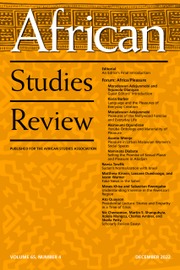Pipeline is a densely populated neighborhood in Nairobi, Kenya, known for its high-rise apartment buildings and vibrant migrant community. Located in the Embakasi South area, it is home to low- and middle-income workers seeking a better life in the capital. The neighborhood’s bustling streets, informal businesses, and matatu (minibus) transport system connect it to downtown Nairobi, yet rapid urbanization has led to significant infrastructural challenges, including congestion, unstable water access, and limited sanitation. These conditions create a complex urban landscape where survival requires resilience, adaptability, and strategic navigation of both economic and social pressures.
Against this backdrop, Mario Schmidt’s Migrants and Masculinity in High-Rise Nairobi: The Pressure of Being a Man in an African City provides an in-depth exploration of how male migrants navigate life in this precarious urban environment. As a crucial contribution to the literature on African urbanization, migration, and gender studies, this book highlights an often-neglected group of young male migrants navigating economic hardship and evolving gender roles in their pursuit of stability.
Migrants and Masculinity in High-Rise Nairobi portrays what has been called ‘the individual experience of social structural oppression’ (P. Bourgois, [Cambridge University Press, Reference Bourgois2003]). It shows how, amidst economic crises and the Kenyan state’s failure to offer affordable healthcare and education, migrant men remain under continuous pressure to provide for their loved ones.
The book is structured into two key sections: “Experiencing Pressure,” which examines the economic and social demands placed on migrant men, and “Evading Pressure,” which explores coping mechanisms such as male sociality, physical fitness, and self-help ideologies. Rather than changing the system or returning to the village, most male migrants in Pipeline sought refuge in homosocial spaces—bars, gyms, and self-help networks—to escape pressure and reaffirm their future success (150). These spaces provided temporary relief while reinforcing dominant masculine expectations, ultimately revealing both the resilience and limitations of male solidarity.
Chapter One explores Pipeline, Nairobi, as an aspirational yet precarious urban space shaped by colonial legacies, postcolonial neglect, and speculative real estate. Schmidt examines how rapid urbanization driven by the demand for affordable housing leads to overcrowding and poor sanitation, further exacerbated by neoliberal governance. The chapter highlights how the physical environment influences residents’ aspirations, particularly migrant men’s economic ambitions and masculine identities, portraying Pipeline as a space of resilience and opportunity that challenges simplistic slum narratives.
Chapter Two focuses on how financial instability and gendered expectations of masculinity shape migrant men’s lives in Pipeline. Schmidt shows how hustling—balancing formal and informal work—becomes a survival strategy, though inconsistent earnings create financial insecurity and performative displays of wealth. Chapter Three expands on this by exploring how economic instability strains romantic relationships, with men critiquing women’s materialism while performing financial success, reflecting societal expectations that link masculinity to economic power. Together, these chapters reveal the impact of economic precarity on gender dynamics and personal aspirations.
Chapter Four explores male sociality in Nairobi’s migrant communities, where welfare groups and informal spaces offer emotional support but also encourage “wasteful masculinity” through excessive spending on alcohol and entertainment. These male-exclusive networks marginalize women and prioritize short-term gratification over stability. The COVID-19 pandemic exposed their fragility, as economic pressures led to the collapse of many groups, revealing the limits of male solidarity.
Chapter Five examines gym culture in Pipeline, where weightlifting becomes a tool for migrant men to assert control and navigate identity amid economic challenges. Schmidt highlights how gyms like No Mercy Gym foster collective masculinity and social hierarchies while reinforcing patriarchal norms. Class disparities are evident, with elite gyms contrasting informal setups for working-class migrants. Chapter Six discusses the rise of masculinity consultants—self-help authors, influencers, and pastors—who promote financial discipline and critique feminism. These figures reinforce male authority while depoliticizing structural inequalities, in line with Ferguson’s critique of neoliberalism, which shifts the burden of success onto individuals (J. Ferguson, [University of California Press, Reference Ferguson1999]).
Schmidt provides a nuanced and well-researched exploration of migrant masculinity in Nairobi, effectively linking economic precarity with gender performance. The book’s ethnographic depth, drawn from extensive fieldwork, offers compelling insights into how men navigate societal pressures, while its interdisciplinary approach, bridging urban studies, migration, and masculinity, makes it a valuable contribution to African studies and gender discourse. However, by not incorporating women’s voices to a fuller extent, the book risks presenting a one-dimensional portrayal of gender relations, overlooking how female agency and economic participation shape and are shaped by the very pressures Schmidt examines.
I highly recommend this book to scholars and professionals in urban studies, gender studies, and migration research. With rich ethnographic detail, Schmidt exposes the tensions between economic survival and gender expectations, challenging us to rethink success in an unstable system. Masculinity, as Schmidt reveals, is not just performed, it is constantly negotiated.


